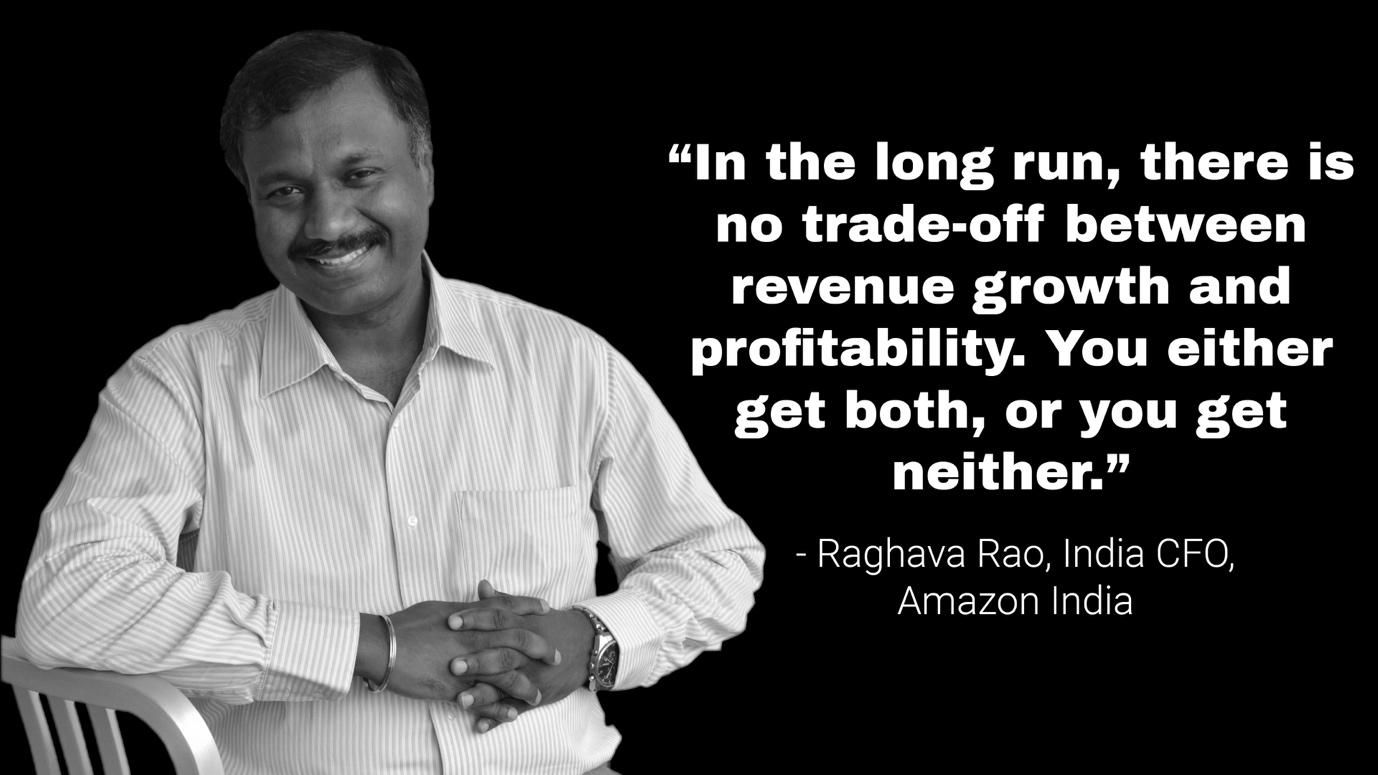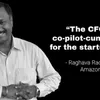In the first part of the ExpertSpeak Series, Raghava Rao, India CFO, Amazon India, addressed several key points on the role of a Chief Financial Officer(CFO) in startups and the value a CFO brings to the table. I was grateful for the insights that Raghava provided.
In this concluding part, Raghava delves deeper into how a CFO should handle shareholder expectations and conflict, striking the right balance between growth and profitability, and dealing with the dynamic, unpredictable world of startups.
Vani Kola (VK): How can a CFO handle shareholder or investor expectations and conflict? How do you approach financial planning or reporting when a startup is answerable to so many investors?
Raghava Rao (RR): The litmus test for any CFO is to handle shareholder expectations and conflicts and minimise distraction for the operating team due to these conflicts. Some of the factors that help a CFO pass this test are as follows:
Build and retain the trust of the board and the investors
Trust is earned in good times through regular communication. A good CFO communicates regularly with the board or investors. The tone of the communication is objective and is neither exuberant nor pessimistic even when performance and results may justify either tone.
Ensure that the management and operating team receive regular guidance from the board.
Ensure that the communication is two-way, and the feedback from the board flows to the operating team, is incorporated and there is report-back.
Manage expectations
Bringing inputs from economic forecasts, industry outlook, and competitor performance, regulatory landscape, and using this as input for goal-setting with the board helps manage expectations.
Demonstrate an ability to build the financial and non-financial long-term roadmap for the future
An annual long-term rolling forecast, usually for three years, is a recommended practice that helps extend the horizon for planning for the startup’s operating management team. Getting a sign-off from the board on this rolling horizon is a great way to build in stable outlook on performance and ambition.
Build mechanisms around quarterly reviews with the operating management team
By this, I mean review, performance analysis, agreement on course corrections, and driving reallocation of resources. This could be anything from an increase or decrease in headcount, marketing spends, or customer discounts. But importantly, the CFO guides you on those decisions and links them to the right metrics.
Demonstrate courage and integrity
The CFO should call out things when they are not going on track and have the backbone and courage to force a discussion on unpleasant conversations.
VK: When it comes to growth and profitability, how can a founder find the right balance, and how can a CFO help founders reach that?
RR: I think you mean the trade-off between revenue growth and margin expansion. There’s a phrase, which is very apt for this.
Be stubborn on the vision, but flexible on the details.
In the long run, there is no trade-off between revenue growth and profitability. You either get both, or you get neither. Revenue growth helps you get the scale and operating leverage to improve margins. Improvement in margins helps secure investor confidence to invest in the right initiatives that will continue driving growth. For a startup there, Get Big and Get Fit are two sides of the same coin.

However, on a transactional basis, it is acceptable to occasionally play off one for the other (between growth and margins).
It sounds really simple, but making sure that the leadership team understands and internalises that in the long-term revenue growth and bottom-line growth feed on each other and are entirely interdependent — even while in the short term there are transactional tradeoffs — is one of the most important mental models for a CFO to develop with their operating leadership team.
So, have checkpoints, therefore, every three or six months, and hold yourself accountable for growth in the topline and bottom-line. Important artefacts for the CFO to make the operating team aware are — What is the operating leverage I get with every percentage point of price increase? Or with every percentage point of volume growth? What is my operating leverage on fixed costs? How do my variable costs change with scale? Or time? What are the underlying cost drivers for my variable costs — revenue or defects? How does inflation impact my revenue line? Cost lines?
Another tip is that cash flows are a unifying factor between revenue growth and profitability. Cash flows can come both revenue growth and margin expansion, and if goals are set on cash flows, much (but not all) of the debate on tradeoffs between growth and profitability disappears.
Yet another learning is to link cash flows with customer metrics. If you can express your cash flows in terms of — Are my customers growing? Are they loyal to my product or service? Do I measure cash flows on a customer x timeline dimension? Are my cashflows per customer growing over time? Formulating the equation using the above variables helps resolve any conflict between revenue growth and margin expansion.
VK: CFOs are trained to be analytical and critical thinkers. But a startup is often beset by unpredictability. Would this unpredictability divert from the traditional skills and training of a CFO and require a new outlook?
RR: A CFO must have the ability to keep learning and stay humble.
Once you have that quality, you are willing to absorb new news and developments and make changes in your operating plan, no matter how unpredictable the external ecosystem. If somebody asked me what has changed in leadership over the last 10 or 20 years, I would say that then leaders were fairly rigid in their assumptions and thinking.
That old leadership style is not going to work, and COVID-19 is a brilliant reminder for this. Therefore, I think a CFO needs to be very flexible, be able to revise their points of view, which could be the financial plan or strategy, or the underlying metrics and milestones for that financial plan.
Former US President and WWII General Dwight Eisenhower had a fantastic quote: “Long-term plans are useless, but planning is everything!”
If you can build in that flexibility when you plan, it gives you the right balance to strike.
Startups live in a VUCA world — a world that is Volatile, Uncertain, Complex, and Ambiguous.
The mantra that works best for CFOs is to counter Volatility with a steady Vision, counter Uncertainty by building Clarity around a framework for decision making amidst Uncertainty, handle Complexity by keeping things simple, scalable, and modular, and deal with Ambiguity by building in Agility into your plans.
VK: What are the challenges that you see the most for a CFO in a startup? How do these differ from the challenges that CFOs from established industries face?
RR: One common challenge is how do I manage short-term tradeoffs vs. long-term objectives? A common expression of this challenge is the constructive tension between revenue growth and driving margin expansion that I covered earlier.
Next, I would consider the dilemma about when to challenge the passion that a promoter has with being a little hard-nosed and saying, “wake up and smell the coffee!”
Having that courage and knowing when to have that conversation about idealism vs. realism is also important. You can’t have this conversation every day. You would probably bring in pessimism into it then!
Third, when the startup invests in creating capability or driving customer adoption or trials, this investment often creates a cost structure that is ahead of the actual growth curve. Knowing whether the cost structure you are creating is too early or too much is often a key dilemma. For example, should I hire 100 more people today ahead of actual growth, or should I wait for another three months and then hire them?
The fourth challenge is when you think you are performing really well, and you have faith in your business model, vision, and team. But every once a while, a competitor shows up on the landscape, performs better, and challenges whatever assumptions you had until then held as the gospel truth. The competitor rains on your parade! That’s when you realise that you need to change. Or, paradoxically, should you still hold on to what you are doing and stay the course? That’s another dilemma.
It is always a challenge to rethink notions held very close to the head and the heart. In other words: When do I abandon my assumptions?
VK: What are your top recommendations for building sound financial systems and processes for startups?
RR: My recommendations can be categorised into four categories:
1. Controllership
Controllership is non-negotiable and first on my list, along with embedding compliance, IT, and taxation.
2. Analytics
A startup CFO always wonders about when to start automating their part of the business.
My framework is that automation can come later. Don’t make the mistake of automating things too early.
But if I want to make a trade-off between investing in automation versus investing in analytics, I would choose analytics every time.
By building an analytic capability, I mean building the team, tools, capability, and mechanisms to mine data. This is critical, especially these days when most startups are digital startups.
3. Business finance and decision support
Very often, CFOs invest only in compliance, accounting, and reporting functions. They don’t invest in what I call business decision support or building a team of business finance partners.
A Business Finance partner sits alongside the Business Leader or the Business Leader’s direct reports, listens in on their conversations, and acts as their left-hand or right-hand. And then, over a period of time, injects finance acumen into business decisions without being burdened down by accounting or cash flow management, which gets handled separately.
If you marry a strong analytical capability with a strong business finance team, you get the very remarkable ability to convert data into information, information into insights, drive those insights into action, and then drive action to make predictions! This is critical for digital startups.
4. Automation
After the above three steps, I would come to automation. Obviously, you need to automate to be able to build scale. But knowing when to do it is important. Automating too early has its pitfalls just as automating too late.
Conclusion:
Listening to Raghava made me aware of the acuity he brings into understanding the complexities of the startup ecosystem. He showed us how CFOs who are well-connected to the overall startup business could drive execution and strategy.
This was a thought-provoking dialogue that explored challenging topics where Raghava shared so many of his leading practices. I thank Raghava for the time he spent talking to me, and I hope we will interact again soon.
ExpertSpeak will continue to share insights and perspectives from industry leaders.
This article was first published here on LinkedIn
Edited by Saheli Sen Gupta
(Disclaimer: The views and opinions expressed in this article are those of the author and do not necessarily reflect the views of YourStory.)
Link : https://yourstory.com/2020/11/amazon-india-raghava-rao-value-cfo-company-vani-kola
Author :- Vani Kola ( )
November 11, 2020 at 03:13PM
YourStory

